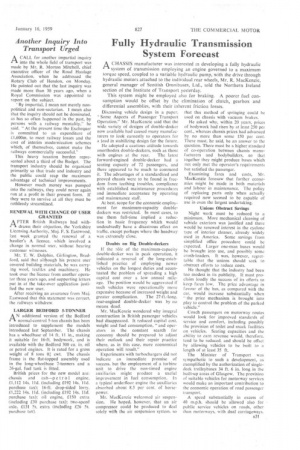Fully Hydraulic Transmission System Forecast
Page 35

If you've noticed an error in this article please click here to report it so we can fix it.
A CHASSIS manufacturer was interested in developing a fully hydraulic A. system of transmission employing an engine governed to a maximum torque speed, coupled to a variable hydraulic pump, with the drive through hydraulic motors attached to the individual rear wheels, Mr. R. MacKenzie, general manager of Scottish Omnibuses, Ltd., told the Northern Ireland section of the Institute of Transport yesterday.
This system might be employed also for braking. A poorer fuel consumption would be offset by the elimination of clutch, gearbox and differential assemblies, with their inherent friction losses.
Discussing vehicle design in a paper, "Some Aspects of Passenger Transport Operation," Mr. MacKenzie said that the wide variety of designs of double-decker now available had caused many manufacturers to look earnestly to operators for a lead in stabilizing design for the future.
He adopted a cautious attitude towards unorthodox double-deckers, such as those with engines at the rear. The latest forward-engined double-decker had a seating capacity of 72 passengers, and there appeared to be much to commend it. The advantages of a standardized and proved chassis were to be found in freedom from teething troubles, compliance with established maintenance procedures and immediate acceptance by operating and maintenance staff.
At best, scope for the economic employment for maximum-capacity doubledeckers was restricted. In most cases, to use them full-time implied a reduction in basic frequency which would undoubtedly have a disastrous effect on traffic, except perhaps where the headway was extremely close.
Doubts on Big Double-deckers
If the role of the maximum-capacity double-decker was in peak operation, it indicated a reversal of the long-established practice of employing newer vehicles on the longest duties and accentuated the problem of spreading a high capital cost over a low annual mileage. The position would be aggravated if such vehicles were operationally more expensive because of increased weight and
greater complication. The 27-ft.-long, rear-engined double-decker was by no means dead.
Mr. MacKenzie wondered why integral construction in British passenger vehicles had disappeared. It reduced capital cost, weight and fuel consumption, "and operators in the constant search for economy should be prepared to adjust their outlook and their repair practice where, as in this case, more economical operation will result," Experiments with turbochargers did not indicate an immediate promise of success, but the employment of a turbine unit to drive the non-timed engine auxiliaries might produce a useful improvement in fuel consumption. In a typical underfloor engine the auxiliaries absorbed about 8.5 per cent, of horsepower.
Mr. MacKenzie welcomed air suspension. He hoped, however, that an air compressor could be produced to deal solely with the air suspension system. so
that this method of springing could be used on chassis with vacuum brakes.
He asked why, within 20 years, prices of bodywork had risen by at least 250 per cent., whereas chassis prices had advanced by no more than some 150 per cent. There must, he said, be an answer to the question. There must be a higher standard of co-operation between chassis manufacturers and bodybuilders, so that together they might produce buses which not only met the operator's requirements but satisfied the passenger.
Examining fares and costs, Mr. MacKenzie foresaw that further economies might be made in both materials and labour in maintenance. The policy of replacing parts only when actually required now seemed to be capable of use in even the largest undertaking.
Unions Obstruct Savings Night work must be reduced to a minimum. More mechanical cleaning of vehicle exteriors was justified and there would be renewed interest in the cyclone type of interior cleaner, already widely used in America. Some savings from simplified office procedure could be expected. Larger one-man buses would be brought into use, and possibly some crush-loaders. It was, however, regrettable that the unions should seek to obstruct efforts to reduce costs.
He thought that the industry had been too modest in its publicity. It must proclaim loudly the success of its efforts to keep fares low. The price advantage in favour of the bus, as compared with the car, would increase substantially when "the price mechanism is brought into play to control the problem of the parked vehicle."
Coach passengers on motorway routes would look for improved standards of service and comfort, including possibly the provision of toilet and snack facilities on vehicles. Seating capacities and the ability to earn revenue would, therefore. tend to be reduced, and should be offset by allowing vehicles to be built to a length of at least 35 ft,
The Minister of Transport was sympathetic to such a development, as exemplified by the authorization of singledeck trolleybuses 34 ft. 6 in. long in the built-up areas of Glasgow. The provision of suitable vehicles for motorway services would make an important contribution to the economic operation of road passenger transport.
A speed substantially in excess of 40 m.p.h. should be allowed also for public service vehicles on roads, other than motorways, with dual carriageways.








































































































